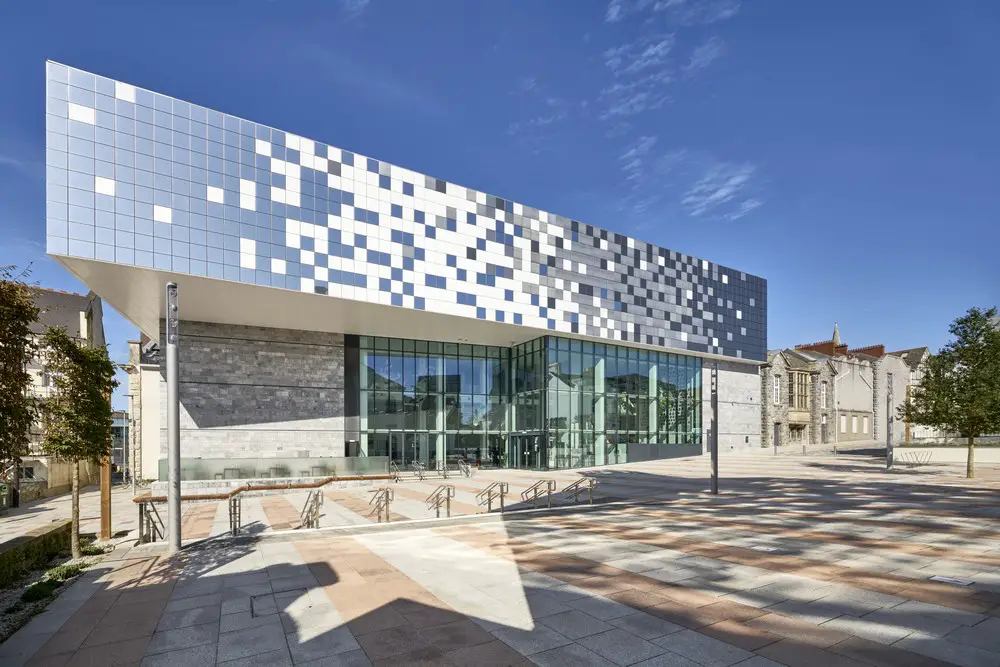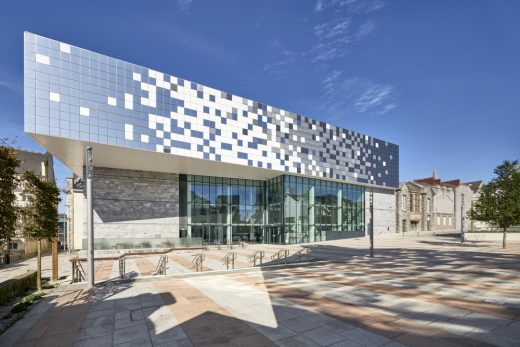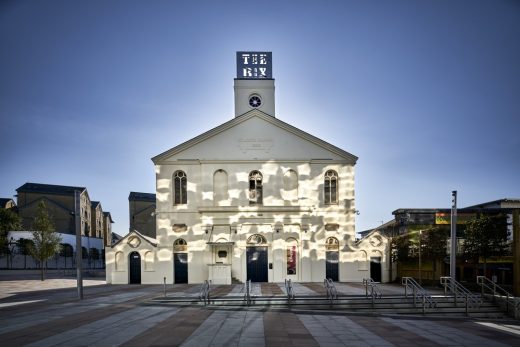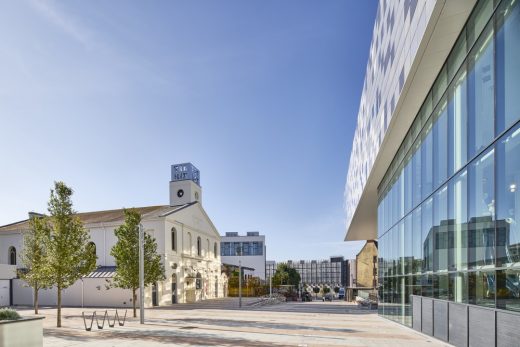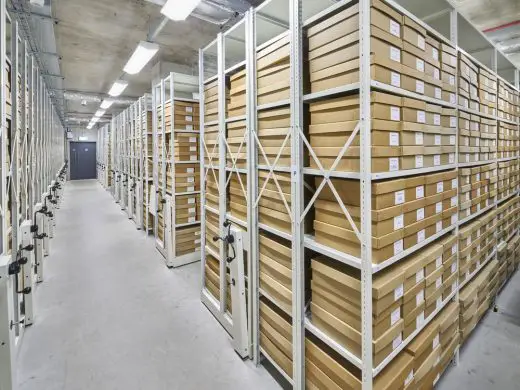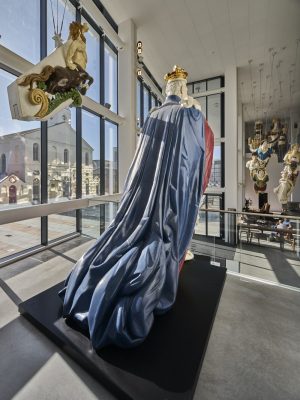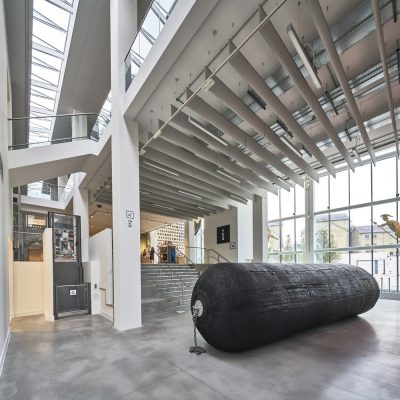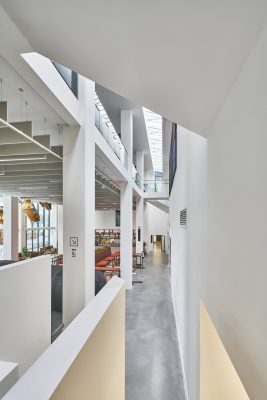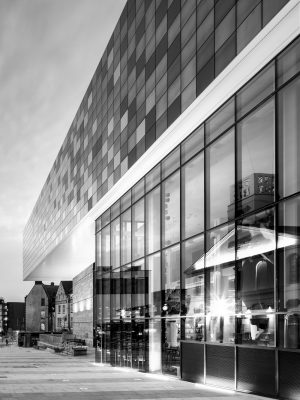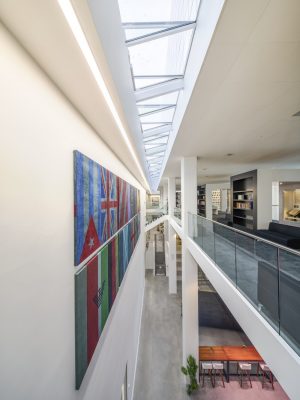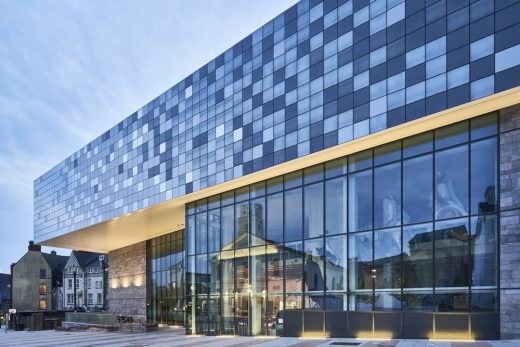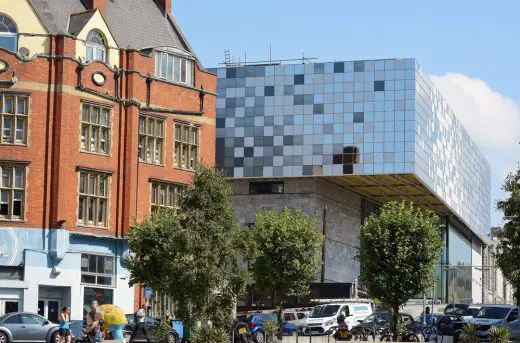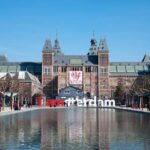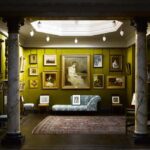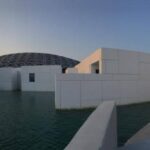The Box Plymouth Cultural Centre Building, St Luke’s Church Renovation Images, Devon
The Box and St Luke’s Church, Plymouth
28 Sep 2020
The Box, Plymouth
Architects: Atkins
Location: Plymouth, Devon, Southwest England, UK
Project Overview:
The Box is a £46m project to transform Plymouth’s Grade II listed museum, library and adjacent church into a cutting-edge facility, boasting interactive collections housed in an exhibition space three times greater than the site’s original size.
The aim of the project was to bring together disparate heritage collections, contemporary arts and the archive into a single entity – a unique proposition in the UK.
Atkins multi-disciplinary design team provided the creative and technical expertise to enable the realisation of this transformational construction project for Plymouth City Council. The scheme comprised the alteration, refurbishment and extension to three Grade II listed buildings to incorporate museum exhibition halls, GIS compliant art galleries and specialist PD 5454 archival stores, while externally a new piazza has been created to unify the heritage and arts complex.
The Box provides a heart to the new Cultural Quarter of the city, and its 2020 opening aligns with the 400th anniversary of the Mayflower sailing to America.
Key Facts:
- A £40m project to transform Plymouth’s Grade II listed museum, library and adjacent church into a cutting-edge facility boasting 7 galleries and 6 exhibition areas, in a space three times the original site’s size.
- The weightiest component of the building – the archive – sits on the top floor of the new museum and, thanks to the redesign of the lower floors, boasts a double cantilever; overhanging 8m to the east and 2m to the south, 10m above the ground.
- The archive, which will house 24,000 boxes, has been designed to maintain stable temperature and humidity conditions with minimum reliance on mechanical controls.
- A 55m² lobbied frozen store has been incorporated into the basement below the main space, formed from 300mm thick concrete to provide four-hour fire compartmentation.
- A new piazza links the buildings and is framed by pleached trees and a grid of American Elm trees, representative of the state tree of Massachusetts. In addition to providing enhanced biodiversity on site, the trees nod to Plymouth’s historic links with North America.
- A live, shared model was created during the design process, exceeding the requirements of BIM Level 2. The model enabled rapid assessment of the area and an understanding of the form and scale of the site’s new design. It has been reused by the wider consultant team and the client’s exhibition designers.
Design:
Museum and Library
The original museum and library buildings were completed in the early 20th century. Though built four years apart, the unifying appearance of the Edwardian facades gave the impression of a single building.
Working in collaboration with exhibition designers, Atkins’ design has seen the existing buildings converted into interactive exhibition spaces, home to a giant mammoth gallery, a flotilla of 14 original naval ship figureheads, the oldest ‘coat’ in Europe and interactive maps. Leader of Plymouth City Council, Tudor Evans stated:
“The concepts look incredibly exciting. Atkins has come up with a really striking building and some of the interior spaces will be jaw-dropping.”
The Box has a national collection, with the most valuable artefacts arranged in a secure public room, which also doubles as the study room for the whole collection. Paying homage to William Cotton III, who donated a substantial collection to museum in 1816, the room is based on an Edwardian gentleman’s living room.
Capping off the space is the ‘archive in the sky’, the façade of which is made up of 149 panes of glass. The archive houses the most valuable artefacts in the collection in a closely controlled environment. It spans beyond the perimeter of the building, overhanging the entrance and terrace area in a contradiction that sees the heaviest part of the building floating 10m above the street. The movement of the archive into a top floor ‘box’ was a key component in Atkins’ design. Internally, moving the records has afforded visitors greater movement around the rest of the site and its exhibitions. From an external perspective, the archive peeks above the surrounding buildings to signpost its presence and highlight the site’s main entrance.
A new atrium has also been built, adjacent to the original site – connected via a glazed slot providing a visual separation of the old and the new. It is home to the reception area, a café and shop, as well as a new study space on the first floor.
St Luke’s Church
Built in 1828, St Luke’s Church has been sympathetically restored to showcase its classical façade of tetrastyle Tuscan pillars, while a new chancel window has been created by international glass artist Leonor Antunes. Inside, the GIS-compliant space has seen the original pews removed and an exhibition space created on the new mezzanine.
Originally ‘crowd funded’ and built by the people of Plymouth, the church is now returned to the city for cultural use.
Piazza
The piazza – the first public square to be built in Plymouth since 2004 – encompasses the former Tavistock Place Road and the demolished garaging to the side of St Luke’s Church. The area forms the link between the two buildings of the complex and is fully serviced to support external events, exhibitions and food outlets. The piazza is framed by pleached trees to the north boundary and a grid of American elm trees, representative of the state tree of Massachusetts. In addition to bringing biodiversity to the area, the trees give a nod to the city’s historic links with North America.
Innovation:
Integrated Conservation Management Plan – Conservation Management Plans (CMP) were required by the Heritage Lottery Fund for both the listed buildings and for the collection. Conservation specialists from Atkins and Faithful+Gould worked proactively with the collection managers to establish and create the combined CMP.
Live model – A 3D working model of the site was created to showcase the design to the client team. It enabled rapid assessment of proposed ideas and assisted in visualising the form and scale of The Box, both internally and externally. The model has also been used productively by exhibition designers and interior visualisers. By offering a variety of viewpoints from around the city, Atkins was able to demonstrate to the planning authority, Historic England and the Victorian and Edwardian Society as to why the height of The Box is architecturally optimised.
The gravity defying structure – Atkins’ architectural concept for the site included a four-sided box to house the archive, which would sit atop The Box and be supported on a double row of 10m high square columns, split by the first-floor mezzanine. The redesign of building access on the lower floors meant that an external double cantilever was required for the archive, spanning 8m to the east and 2m to the south. The height of the perimeter walls together with the provision of internal cross walls was used to achieve this cantilever, and a row of unbroken 10m columns on the external façade provided further support beyond the stair cores to the north and south.
Suspension of historic figureheads – During the construction works, 14 historic naval ship figureheads benefited from comprehensive conservation treatment and are now suspended within the entrance space of the new extension.
A specialist team of conservation consultants analysed the figureheads and, in consultation with Atkins, devised a method of support that could be fixed to the soffit of the completed archive without compromising the structural integrity or the four-hour fire compartmentation.
GIS in the church – In order to operate as an exhibition space, the church had to meet the requirements of the Government Indemnity Scheme (GIS). Stable internal conditions and security were essential components to be addressed. Atkins was tasked with solving these challenges in a manner that did not detract from the original quality of the space in the church. The outer walls of the main church building were lined with a deep exhibition wall concealing extensive air-conditioning equipment, this wall provided the robust support structure for fixing of the indemnified art works, and the linings contained reinforcement at window positions to protect against intrusion.
Leaded glass lightboxes – The external windows in the church were in poor condition. The lead and the bronze reinforcing bars had corroded and were no longer water-tight; the painted and stained glass was incomplete; and the leaded panes were bowing under their own weight. The windows were removed and taken to a specialist conservation studio for repair and replacement of the lead. However, natural light from the windows was deemed detrimental to the public gallery proposed to be housing within the church. Atkins’ solution involved creating permanent display walls inside, within which a deep, top-lit lining was provided so that when viewed from outside the church appeared to still possess internally lit stained-glass windows. These tall shards of light now animate the north wall of the church.
Controlled environment – The archive has been designed to maintain a stable temperature and humidity, with a minimum reliance on mechanical controls. The external walls, roof and floor provide thermal and hygroscopic mass to prevent internal fluctuations that could be harmful to the collection.
This is achieved via the 300mm thick concrete shell. Apertures opening directly into the archive are avoided as these would form weak points; every entrance is lobbied, smoke vents are via a secondary space, and pressure vents are avoided as a gaseous fire suppression system is not required. Mechanical ventilation is provided for regular public tours and is electrically powered via the solar panels concealed behind the parapet of the archive box.
Services Provided
(RIBA Stage 1 – 7 inclusive with selective CDPs)
– Architecture
– Conservation Architecture
– Landscape Architecture
– Conservation Surveyor (Faithful+Gould)
– Structural Engineering
– Mechanical, Electrical and Plumbing Engineers
– Civil Engineering
– Highways Engineering
– Interior Design and Space Planning
– Heritage Consultant
– Principal Designer
– Cost Consultancy (Faithful+Gould)
– Planning Consultancy
– Access Consultant (Faithful+Gould)
– Acoustician
– BREEAM Consultancy
The Box and St Luke’s Church Plymouth – Building Information
Sub-consultancy appointment for Project Management – Ward Williams, Contract Administration – Ward Williams, and Clerk of Works – Gage Tupper.
Contractor:
Main Contractor – Willmott Dixon
MEP Contractor – T Clarke
The project was completed in partnership with main contractor Willmott Dixon and an extensive sub-contract team, almost 80% of whom were from the local PL postcode area.
Start date: November 2014
Completion Date: February 2020
Key Contacts:
- James Harrison, Project Design Director, Atkins
“Working closely with Plymouth City Council over the past few years, this project has been a great opportunity to demonstrate our multi-disciplinary expertise to deliver a project that will benefit the local region for decades to come. The sympathetic transformation of the Grade II listed buildings into a cutting-edge interactive centre is a great demonstration of how the old and the new can so beautifully blend together. It’s great to see the doors open and the public able to experience all that The Box has to offer.”
- Kevin Presland, Senior Architect, Atkins
“The Box has been a rewarding project for Atkins, drawing upon the broad skillset of our multi-disciplinary team, while personally it has been a great opportunity to make a positive contribution to my student city through the creation of a vibrant new public space that provides improved public access, showcases six of the UK’s national collections and ties together the area’s heritage with modernity in the city’s new cultural quarter.
“The play of light and reflection in The Box’s design is one of my favourite features; the ever-changing appearance and colour of the cladding reflecting the weather; the passage of the morning sun across the South Hall defined by the curtain walling mullions and the figureheads; and the afternoon sun reflected onto St Luke’s from the glazed façade.”
- Councillor Tudor Evans, Leader of Plymouth City Council
“We have an epic history and some incredible archives – from an Elizabethan document dating from 1587 that gave Sir Francis Drake permission to be a privateer, to the city’s Bomb Book and of course, the original pasty recipe.
“For too long, we haven’t been able to show them off. Part of The Box’s vision was to create a dramatic and suitable new home for Plymouth’s treasured collections and now we have one. This is cultural regeneration at its best.”
- Caroline Cozens, Programme Manager for The Box, Plymouth City Council
“We wanted to put our incredible archives front and centre of The Box and where these precious documents should be stored formed a key part of the design. Rather than being in a warehouse or in a basement we wanted them to reflect how important they are by creating something bold and striking. The Box is on a dense inner-city site and the only way to build was up.”
- Robert Woolcock, Director, Willmott Dixon
“The Box is so much more than a construction project – it’s an opportunity to bring Plymouth’s past into the present and create a legacy for the future. We are very proud to have been involved in this landmark project that supports and preserves Plymouth’s history and culture for new generations as well as providing an iconic attraction for visitors.”
Previously on e-architect:
The Box in Plymouth
Architects: Atkins
Location: Plymouth, Devon, Southwest England, UK
The Box and St Luke’s Church Cultural Centre in Plymouth
Architects: Atkins
Photography: The Box Museum Plymouth – Wayne Perry
The Box and St Luke’s Church Cultural Centre in Plymouth images / information received 050220 from Atkins
Location: Plymouth, Devon, England, UK
Plymouth Architecture
The House in Plymouth
Design: Burwell Deakins Architects
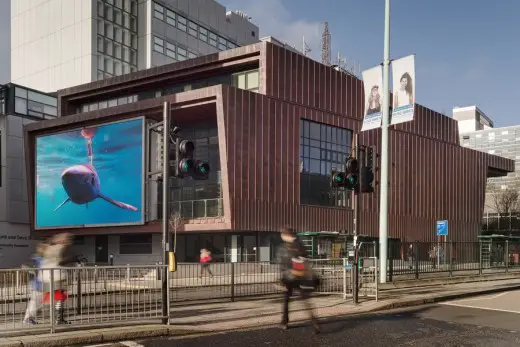
photograph © Christopher Heaney
Plymouth University Building
Pavilions Arena Plymouth
Design: BDP
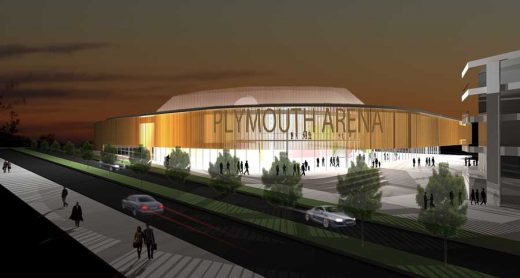
picture from architects
Pavilions Arena Plymouth
Plymouth Theatre Royal
Design: Ian Ritchie Architects
Plymouth Theatre Royal : Stirling Prize nominee 2003
University of Plymouth – Roland Levinsky building
Design: BDP + Henning Larsen Architects
University of Plymouth Building
Bircham Park masterplan, Derriford, North Plymouth
Design: S333 Architecture + Urbanism
Plymouth Masterplan
Liveable Exeter
Design: LDA Design
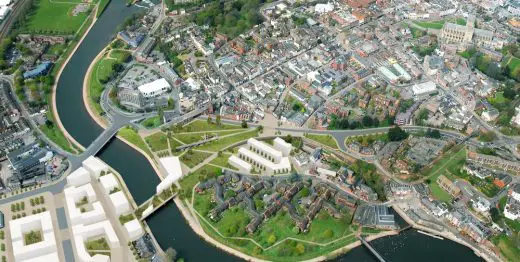
image courtesy of architectural office
Liveable Exeter Devon housing
Eden Project, Cornwall
Design: Grimshaw Architects
Comments / photos for The Box Plymouth Cultural Centre page welcome
Website : Plymouth

